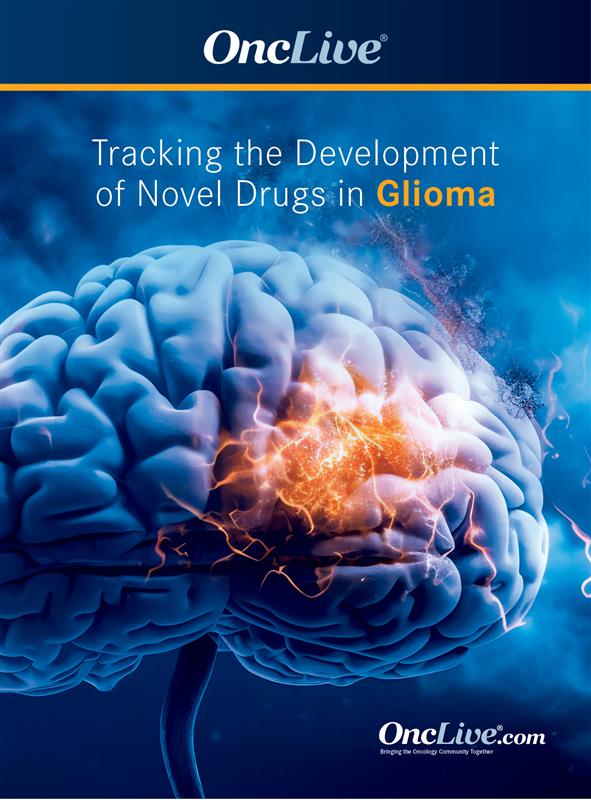Publication
Article
Supplements and Featured Publications
ONC201 Looks to Prove Efficacy in Trial For Rare H3K27M-Mutated Diffuse Midline Gliomas
Author(s):
The dopamine receptor D2 antagonist ONC201 is under evaluation in patients with H3K27M-mutated diffuse midline glioma in the phase 3 ACTION trial.
Stephen Bagley, MD, MSCE

Following encouraging early efficacy signals seen in patients with H3K27M-mutated diffuse midline glioma, the dopamine receptor D2 (DRD2) antagonist ONC201 (dordaviprone) is aiming to improve upon the standard of care (SOC) of radiotherapy for this subset of patients, according to Stephen Bagley, MD, MSCE. The agent is under evaluation in the currently enrolling phase 3 ACTION trial (NCT05580562).1
“For patients [with] newly diagnosed diffuse midline glioma, once they complete SOC radiotherapy, there isn’t anything that’s been proven to improve outcomes. Rather than waiting for a recurrence of the tumor and then seeking out clinical trials such as chimeric antigen receptor [CAR] T-cell [therapy], the ACTION study represents an opportunity for patients to have access to an experimental therapy as part of first-line SOC. It provides access earlier in the disease course,” Bagley said in an interview with OncologyLive.
Currently, the SOC treatment for patients with H3K27M-mutated gliomas is radiotherapy as no systemic therapies have proven to be effective.2 However, select centers will treat patients with temozolomide (Temodar) as adjuvant therapy with radiotherapy, but the efficacy of temozolomide in diffuse midline glioma with an H3K27M mutation is not clear.3 Moreover, patients with an H3K27M mutation also have high expression of 06-methylguanine DNA methyltransferase, which is known to confer resistance to temozolomide.
Notably, in a pooled analysis of patients with H3K27M-mutated diffuse midline glioma receiving ONC201 (n = 50), 88.0% of patients received prior temozolomide which investigators noted was despite a lack of clear efficacy with the therapy in this patient population. They hypothesized administration of temozolomide was likely because it previously demonstrated efficacy combined with radiotherapy in patients with newly diagnosed glioblastoma who were not molecularly selected.2
Ashley Sumrall, MD, FACP, added in an interview with OncologyLive that the mechanism of action of ONC201 may make it an efficacious agent for patients with H3K27M-mutated diffuse midline glioma. “ONC201 is a fascinating compound. When we first started using it in the clinical trial setting, we weren’t even sure of the mechanism [of action]. A small team [investigated] this drug and followed it through,” Sumrall said. “We now know that the compound works through a unique mechanism, targeting DRD2. ONC201 essentially activates a stress response, which leads to programmed cell death in cancer cells. The deep part of the brain seems to be enriched with those receptors, and therefore, patients [with deep brain tumors] will respond well to this medicine if they’re fortunate.”
Diving Into ONC201 and Targeting H3K27M
The small-molecule therapy ONC201 has specifically shown efficacy in patients with H3K27M-mutated gliomas. In the first phase 2 study (NCT02525692) of oral ONC201 for adults with recurrent bevacizumab (Avastin)-naive glioblastoma, 1 patient enrolled who had H3K27M-mutated thalamic glioma achieved a near complete durable response, leading investigators to turn their focus to developing the agent for patients with H3K27M-mutated disease. Based on preclinical data and the response experienced by this 22-year-old female patient, including the complete regression of the primary thalamic lesion, investigators began to further evaluate ONC201 in patients with H3K27M-mutated diffuse midline glioma.3,4
“This drug has shown significant promise in findings from earlier-phase, single-arm clinical trials in patients with diffuse midline glioma, a rare glioma that is typically more common in children but can be seen at any age,” Bagley, an assistant professor of medicine and section chief of Neuro-Oncology at the Hospital of the University of Pennsylvania and Abramson Cancer Center in Philadelphia, said. “Diffuse midline glioma affects midline structures from the spinal cord to the brainstem up to the thalamus. Historically, this has been a very difficult tumor to treat.”
Sumrall added that “the tumors we commonly think of as having the H3K27M mutation are midline, [occurring in] the spinal cord, the brainstem, and the deep centers of the brain. However, [based on] medical literature and anecdotes from speaking to colleagues, people have also seen this mutation in the cerebellum, the thalamus, and other areas where perhaps it’s unexpected. The brain doesn’t always read the instruction manual. I will often tell [colleagues] that if [a patient has] a deep brain tumor or a tumor [they] think could have evolved from the midline, [they should] test for the H3K27M mutation.”
Sumrall is the section chief of neuro-oncology and a clinical assistant professor of medicine at Atrium Health Levine Cancer Institute as well as a faculty member for the Internal Medicine Residency Program and the Medical Oncology Fellowship Program at the Atrium Health Carolinas Medical Center, both in Charlotte, North Carolina. She is also clinical assistant professor of medicine in affiliation with the University of North Carolina at Chapel Hill for the Charlotte campus.
Early-Phase Studies Pave the Way for ONC201
When the histone H3K27M mutation is present in diffuse midline glioma, the median overall survival (OS) has been reported to range from 11 months to 15 months. Investigators who assessed data from the phase 1 ONC014 trial (NCT03416530) and expanded access study ONC018 (NCT03134131) found that patients with nonrecurrent H3K27M-mutated diffuse midline glioma treated with ONC201 (n = 35) experienced a median OS of 21.7 months. Median OS varied for patients treated with ONC201 in the 2 trials at 21.7 months in ONC014 (n = 24) and 13.9 months in ONC018 (n = 11), but this was not statistically different. Survival results were consistent in the 2 trials, with 30% of patients surviving for more than 24 months.5
In the recurrent setting, the combined median OS in patients who received ONC201 (n = 36) was 9.3 months from recurrence and the median progression-free survival (PFS) was 3.4 months from recurrence.
Patients with H3K27M-mutated disease enrolled in ONC014 had a median age of 8.2 years (range, 2-21), whereas those in ONC018 were older, with a median age of 23.7 years (range, 4-58). For patients with nonrecurrent disease, the median time from radiation to ONC201 treatment was 1.8 months (range, 0.2-15) in the ONC014 study compared with 3.8 months (range, 1-6) in the ONC018 study. These rates were 3.7 months (range, 2-18) vs 6.8 months (range, 0.5-45) for patients with recurrent disease, respectively.5
A pooled study examining ONC201 also found that the overall response rate in 4 clinical trials and 1 expanded access protocol, including the ONC014 and ONC018 studies, for patients with H3K27M-mutated diffuse midline glioma (n = 50) was 20.0% (95% CI, 10.0%-33.7%) by Response Assessment in Neuro-Oncology for high-grade gliomas criteria. One patient achieved a complete response and 20.0% of patients experienced stable disease. The disease control rate was 40.0% (95% CI, 26.4%-54.8%) and the median duration of response was 11.2 months (95% CI, 3.8-not reached).2
“ONC201 showed radiographic responses in a subset of patients, and on that basis, the ACTION study was designed and is now actively recruiting patients around the world,” Bagley said. “The CAR T-cell trials at this time are still in very early days and are being tested primarily in patients with recurrent refractory tumors who have not responded to radiotherapy and other standard approaches. ONC201 is being evaluated as part of first-line management right now to try to establish a new SOC for this disease.”
Looking to the Phase 3 Setting With ACTION
The double-blind, placebo-controlled ACTION trial is randomly assigning patients 1:1:1 to receive ONC201.1 “There are 3 arms: 2 experimental arms looking at different [schedules] of ONC201 and a third arm, the placebo arm. We are actively recruiting [patients to enroll in] this trial at our site [at Penn Medicine in Philadelphia, Pennsylvania], and there are many others enrolling around the world,” Bagley said. “We anxiously await the results of this important study.”
Patients with a new histologic diagnosis of H3K27M-mutated diffuse glioma with a weight of at least 10 kg at the time of random assignment will be enrolled in the global study. Dosing of ONC201 is based on weight, and patients with a weight of 52.5 kg or more will receive 625 mg of the agent either twice weekly or weekly. Patients with a weight less than 52.5 kg will receive a dose scaled to weight and rounded to 125-mg increments, as the agent is administered via 125-mg capsules. Those in the placebo group will receive a placebo given in the same quantity of capsules.1
“Efficacy is the main question and is the primary end point for this study. This study has a dual primary end point of OS and PFS,” Bagley noted. Secondary end points encompass adverse effects (AEs) and change from baseline in clinical laboratory parameters, among others. Bagley added that there is “enough data at this point to suggest that ONC201 is not necessarily going to be hindered specifically by tumor heterogeneity, [which can be a] problem.”
Bagley explained that the inclusion of a placebo arm in addition to the rarity of the disease may serve as a potential barrier to enrollment. “This is not a common tumor, and even though there are well over 100 centers that are planning to open this study around the world, it’s still a very rare disease, and the trial is a large trial looking to enroll up to 450 patients. With such a rare disease, even with all the centers, this may take a long time to accrue. The other concern is it is a randomized, placebo-controlled trial, and oftentimes, it’s challenging to discuss the use of a placebo in a patient population where the outcomes are generally not very good. Sometimes that can hinder accrual [to trials] for difficult-to-treat cancers such as this one.”
Key exclusion criteria in the trial include having a primary spinal tumor, diffuse intrinsic pontine glioma, any concurrent malignancy, evidence of leptomeningeal spread of disease or cerebrospinal fluid dissemination, and new lesions outside the radiation field. Patients also cannot have received proton therapy for glioma or whole-brain radiotherapy.
Prior Data Show Tolerable Safety Profile With ONC201
Previous data have revealed that ONC201 is well tolerated. Notably, no dose-limiting toxicities were reported with the recommended phase 2 dose of 625 mg once weekly or twice weekly in pediatric patients with H3K27M-mutated glioma.6
“The AE profile of this drug in the earlier-phase studies was very benign, well tolerated, and we don’t expect to see anything different using it in this maintenance setting after radiotherapy,” Bagley said of the ACTION trial.
In the pooled study, the most common any-grade treatment-related treatment-emergent AEs observed in patients (n = 50) included fatigue (34%), nausea (18%), decreased lymphocyte count (14%), headache (10%), and vomiting (10%). Grade 3 toxicities occurred in 20% of patients and included fatigue (10%), rash maculopapular (4%), decreased lymphocyte count (2%), and headache (2%). Twenty-three patients experienced a serious AE (46%) with the most common being hydrocephalus (8%) and nausea (8%). No treatment-related deaths occurred.2
“These would be incredibly significant results [if the ACTION trial findings are positive]; this would be the first systemic therapy to ever show benefit for this very difficult disease. If this is a study with positive findings, there’s reason to believe it would become a SOC and practice changing for newly diagnosed diffuse midline glioma. I can’t speak enough about the importance of this study.”
References
- ONC201 in H3 K27M-mutant diffuse glioma following radiotherapy (the ACTION study) (ACTION). ClinicalTrials.gov. Updated February 14, 2024. Accessed February 15, 2024. https://classic.clinicaltrials.gov/ct2/show/NCT05580562
- Arrillaga-Romany I, Gardner SL, Odia Y, et al. ONC201 (dordaviprone) in recurrent H3 K27M-mutant diffuse midline glioma. J Clin Oncol. Published online February 9, 2024. doi:10.1200/JCO.23.01134
- Yang Z, Sun L, Chen H, Sun C, Xia L. New progress in the treatment of diffuse midline glioma with H3K27M alteration. Heliyon. 2024;10(2):e24877. doi:10.1016/j.heliyon.2024.e24877
- Gardner SL, Tarapore RS, Allen J, et al. Phase I dose escalation and expansion trial of single agent ONC201 in pediatric diffuse midline gliomas following radiotherapy. Neurooncol Adv. 2022;4(1):vdac143. doi:10.1093/noajnl/vdac143
- Venneti S, Kawakibi AR, Ji S, et al. Clinical efficacy of ONC201 in H3K27M-mutant diffuse midline gliomas is driven by disruption of integrated metabolic and epigenetic pathways. Cancer Discov. 2023;13(11):2370-2393. doi:10.1158/2159-8290.CD-23-0131
- Gardner S, Koschmann C, Tarapore R, et al. Safety of ONC201 administered two consecutive days per week in pediatric H3 K27M-mutant glioma patients. Neuro Oncol. 2021;23(suppl 6):67. doi:10.1093/neuonc/noab196.261










